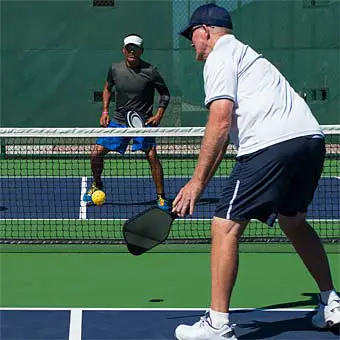Basic Pickleball Rules & Regulations

Rules Governing Play In The United States Of America
Pickleball is a fun and exciting sport that has been growing in popularity in recent years. If you're new to the game, it's important to understand the basic rules and regulations so that you can play the game safely and fairly. Here, we'll go over some of the basic pickleball rules and regulations that you need to know. Complete rules for pickleball play are established by the International Federation of Pickleball.
Basic rules for players and equipment cover the following:
Court and Equipment
Pickleball is played on a court that is similar in size to a badminton court, with a net in the middle. The court is divided into two halves, each of which is further divided into two service courts and a non-volley zone. Players use paddles to hit a plastic ball over the net and into their opponent's court.
Pickleball Court Dimensions - Indoor & Outdoor. The court is 20' x 44' with a net at the center of the 44' dimension. On each side of the net is a 7' x 20' no-volley area known as the kitchen. The remaining area on each side is divided in two creating the left and right service areas. See pickleball court details.
Pickleball Paddles. An official paddle can not exceed a total of 24" when adding the length and width of the paddle, which allows for slight variations in paddle shape. See pickleball paddle details.
Pickleball Balls. The diameter of an official pickleball ball is 2.874 to 2.972 inches with a weight from .780 to .935 ounces. The ball shall have a minimum of 26 to a maximum of 40 circular holes. See pickleball ball details.
Pickleball Serving. The serve is an important part of pickleball, and there are specific rules governing how it should be done. The serve must be hit underhand and from behind the baseline, and it must land in the diagonal service court on the opposite side of the net. The serve must also clear the non-volley zone and not touch the net. The serve motion must be in an upward motion at the time of impact and take place below the waist of the server. The ball must be clearly released from the drop hand before impact with the paddle. The height of the point of impact must be below the height of the wrist. A legal serve must land within the proper service area which includes the right and left border lines, and the baseline. It does not include the line defining the kitchen.
Except for the first service of the game, each team member takes a turn serving and continues until a fault by the serving team. When playing doubles, servers are designated as "Server 1" and "Server 2" to complete the team's turn to serve. See complete pickleball rules.
Pickleball Play. During pickleball play, the player receiving the serve must allow the serve to land in the proper service area before returning the serve. The serving team must then allow the service return to land within the serving side of the court (either service area or the kitchen) before hitting the ball back over the net. Once these two "bounces" have occurred, the ball may be hit back before or after one bounce on the court.
Volleying. Players are not allowed to volley the ball from the non-volley zone, which is a 7-foot area on each side of the net. This means that players must wait for the ball to bounce before hitting it if they are standing in the non-volley zone. However, once the ball has bounced, players are allowed to volley it from anywhere on the court.
The Kitchen. All lines defining the kitchen (non-volley area) are a part of the kitchen. Unless and until the ball lands in the kitchen, volleys must take place with the hitting player remaining completely outside the kitchen. This includes impact and follow through.
Scoring. In pickleball, the first player or team to reach 11 points wins the game, but you must win by two points. If the score is tied at 10-10, play continues until one player or team has a two-point lead. If the receiving team faults during the point, a point is awarded to the serving tea. If the serving team faults during the point, it is considered a "side out" with no points awarded. First team to score 11 points, when leading by 2 points, wins the game. Upon agreement by both teams a game can be played to 7, 11, 15, 21 or any point total mutually agreed upon (except in league or tournament play where the winning number is determined by officiating parties).
Faults. There are several ways that a player can fault in pickleball, including hitting the ball out of bounds, hitting the net with the ball, hitting the ball into the non-volley zone on a serve, and volleying the ball from the non-volley zone. If a fault occurs, the point goes to the other player or team.
Understanding the basic rules and regulations of pickleball is essential if you want to play the game successfully. Keep these rules in mind as you play, and don't be afraid to ask questions if you're unsure about something. With practice and experience, you'll become more comfortable with the game and be able to enjoy it to its fullest. Visit the IFP website for the complete rules for pickleball play and players.

